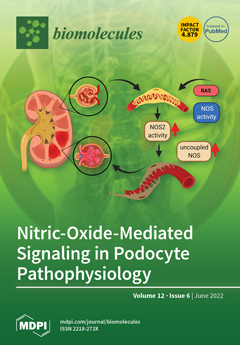Stroke is a leading threat to human life. Metabolic dysfunction of glucose may play a key role in stroke pathophysiology. Pharmacological hypothermia (PH) is a potential neuroprotective strategy for stroke, in which the temperature is decreased safely. The present study determined whether neuroprotective
[...] Read more.
Stroke is a leading threat to human life. Metabolic dysfunction of glucose may play a key role in stroke pathophysiology. Pharmacological hypothermia (PH) is a potential neuroprotective strategy for stroke, in which the temperature is decreased safely. The present study determined whether neuroprotective PH with chlorpromazine and promethazine (C + P), plus dihydrocapsaicin (DHC) improved glucose metabolism in acute ischemic stroke. A total of 208 adult male Sprague Dawley rats were randomly divided into the following groups: sham, stroke, and stroke with various treatments including C + P, DHC, C + P + DHC, phloretin (glucose transporter (GLUT)-1 inhibitor), cytochalasin B (GLUT-3 inhibitor), TZD (thiazolidinedione, phosphoenolpyruvate carboxykinase (PCK) inhibitor), and apocynin (nicotinamide adenine dinucleotide phosphate oxidase (NOX) inhibitor). Stroke was induced by middle cerebral artery occlusion (MCAO) for 2 h followed by 6 or 24 h of reperfusion. Rectal temperature was monitored before, during, and after PH. Infarct volume and neurological deficits were measured to assess the neuroprotective effects. Reactive oxygen species (ROS), NOX activity, lactate, apoptotic cell death, glucose, and ATP levels were measured. Protein expression of GLUT-1, GLUT-3, phosphofructokinase (PFK), lactate dehydrogenase (LDH), PCK1, PCK2, and NOX subunit gp91 was measured with Western blotting. PH with a combination of C + P and DHC induced faster, longer, and deeper hypothermia, as compared to each alone. PH significantly improved every measured outcome as compared to stroke and monotherapy. PH reduced brain infarction, neurological deficits, protein levels of glycolytic enzymes (GLUT-1, GLUT-3, PFK and LDH), gluconeogenic enzymes (PCK1 and PCK2), NOX activity and its subunit gp91, ROS, apoptotic cell death, glucose, and lactate, while raising ATP levels. In conclusion, stroke impaired glucose metabolism by enhancing hyperglycolysis and gluconeogenesis, which led to ischemic injury, all of which were reversed by PH induced by a combination of C + P and DHC.
Full article






